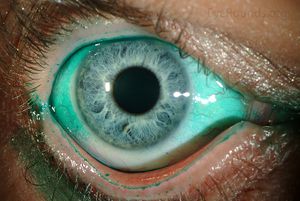Dry eye syndrome

Dry eye syndrome (DES), also known as keratoconjunctivitis sicca (KCS), is the condition of having dry eyes. Other symptoms associated with DES/KCS include irritation, redness, discharge, and easily fatigued eyes. Blurred vision may also occur.[1] Symptoms can be mild and occasional to severe and continuous.[2]
Many risk factors are associated with dry eyes such as aging, frequent flying, smoking, and medications. Health conditions include diabetes, thyroid disease, lupus, rheumatoid arthritis, Sjögren's syndrome, and fibromyalgia.[3][4][5]
Types[edit | edit source]
Environmental triggers such as low ambient humidity, high wind velocity, exposure to airborne particulates and fumes, allergies, nutritional deficiencies, and temperature extremes.[6][7]
View citation by Dr. Mark Guthridge for each cause under "Major Forms of Dry Eye Disease" and "Dry Eye Subtypes".[6]
Major Forms of Dry Eye Disease
- evaporative dry eye
- aqueous-deficient dry eye (related to and not related to Sjögren's syndrome)[6][7]
Dry Eye Subtypes
- dry eye due to tear-film instability
- dry eye due to somatosensory dysfunction
- dry eye due to toxicity
- anatomically related dry eye[6][7]
Symptoms[edit | edit source]
- aching sensations
- blurred vision
- burning sensation
- dryness sensation
- fatigued eyes
- heavy eyes
- itchy eyes
- photophobia (light sensitivity)
- red eyes
- sore eyes[3]
Watery eyes can be a symptom because "dryness on the eye's surface sometimes will over-stimulate production of the watery component of your tears as a protective mechanism. But this "reflex tearing" does not stay on the eye long enough to correct the underlying dry eye condition."[3]
Risk factors[edit | edit source]
Health conditions such as diabetes, thyroid disease, lupus, rheumatoid arthritis, Sjogren's syndrome,[3] and fibromyalgia.[4][5] LASIK and other corneal refractive surgery can cause dry eyes but is usually temporary.[3]
- aging
- computer use
- contact lens wear
- eyelid problems
- frequent flying
- indoor environment
- outdoor environment
- medications
- menopause
- smoking[3]
Treatment[edit | edit source]
A range of treatments are available for dry eyes depending on severity and cause. Artificial tears is usually used for mild cased due to computer use, reading, and schoolwork. Restasis, Xiidra, and steroid eye drops can reduce inflammation. Lacrisert is a solid insert with a preservative-free lubricating agent that slowly liquefies over time which will provide an all-day moistening effect. Punctal plugs are used to help tears remain on the surface of the eye longer. Meibomian gland expression is a procedure to unplug hardened meibum and possibly other substances from the meibomian glands. Warm compresses, which need to maintain a temperature of 108 degrees farenheit for more than 10 minutes twice a day. LipiFlow Thermal Pulsation System (Tear Sicence) is an automated, in office dry eye treatment which combines warm compress therapy and meibomian gland expression. Intense pulsed light treats ocular rosacea. Nutritional supplements containing omega 3 fatty acids can decrease dry eye symptoms.[8]
Some home remedies are to blink more frequently, frequent breaks during computer use, removing eye makeup thoroughly, cleaning eyelids, and wearing quality sunglasses.[8]
Notable studies[edit | edit source]
See also[edit | edit source]
Learn more[edit | edit source]
- Dry Eye Animation[9] Video Short (w/ LipiFlow)
- Tear Break up Time Test Testing for Dry Eye[10] Video Short
References[edit | edit source]
- ↑ "Facts About Dry Eye | National Eye Institute". nei.nih.gov. Retrieved October 4, 2018.
- ↑ Kanellopoulos, Anastasios John; Asimellis, George (January 18, 2016). "In pursuit of objective dry eye screening clinical techniques". Eye and Vision. 3. doi:10.1186/s40662-015-0032-4. ISSN 2326-0254. PMID 26783543.
- ↑ 3.0 3.1 3.2 3.3 3.4 3.5 Adler, Richard. "10 Symptoms of Dry Eye Syndrome + Possible Causes". All About Vision. Retrieved October 4, 2018.
- ↑ 4.0 4.1 Mandal, Ananya; Cashin-Garbutt, April (June 30, 2013). "Fibromyalgia and Dry Eyes and Mouth". News-Medical.net. Retrieved October 4, 2018.
- ↑ 5.0 5.1 Dix, Robin (April 3, 2018). "Fibromyalgia and Sicca Syndrome: Is There a Connection?". Fibromyalgia News Today. Retrieved October 4, 2018.
- ↑ 6.0 6.1 6.2 6.3 Clayton, Janine A. "Dr Mark Guthridge". Twitter. New England Journal of Medicine. Nov 1, 2018 11:17 PM. doi:10.1056/NEJMra1407936. Retrieved November 2, 2018 – via Twitter.
- ↑ 7.0 7.1 7.2 7.3 Clayton, Janine A. (June 7, 2018). "Dry Eye". New England Journal of Medicine. 378 (23): 2212–2223. doi:10.1056/nejmra1407936. ISSN 0028-4793.
- ↑ 8.0 8.1 Adler, Richard. "12 Ways To Relieve Dry Eye Syndrome". All About Vision. Retrieved October 5, 2018.
- ↑ "Dry Eye Animation". YouTube. Kugler Vision. January 10, 2014.
- ↑ "Tear Break up Time Test Testing for Dry Eye". YouTube. Douglas Lavenburg. June 24, 2014.

